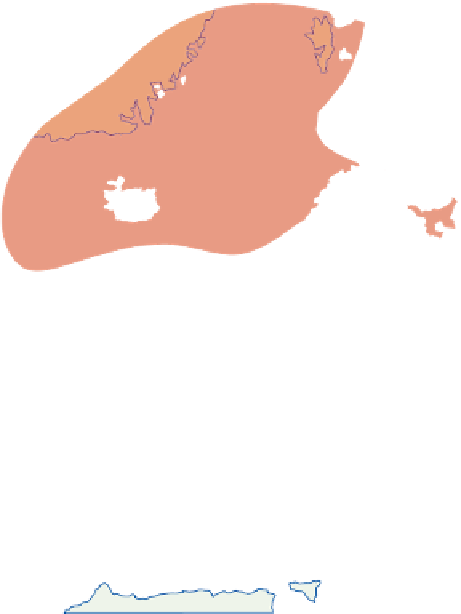Geoscience Reference
In-Depth Information
60°
40°
20°
0°
20°
40°
60°
80°
+
+6
+8
70°
+4
60°N
0
+2
+4
+6
+
+8
+
+2
60°
50°
0
0
50°
-2
-4
-
-
-6
40°
-4
-2
-8
40°
-2
0
0
30°
20°W
10°
0°
10°
20°
30°
40°E
Figure 10.11
The mean surface temperature anomaly (°C) during anticyclonic blocking in winter over
Scandinavia. Areas more than 4°C above normal have vertical hatching, those more than 4°C below normal
have oblique hatching.
Source: After Rex (1950). By permission of Tellus.
Innsbruck, there are approximately 50 days per
year with föhn winds, with a maximum in spring.
Such occurrences can lead to rapid melting of the
snow, creating a risk of avalanches. With northerly
airflow across the Alps, föhn may occur in
northern Italy, but its effects are less pronounced.
Features of upland climate in Britain illustrate
some of the diverse effects of altitude. The mean
annual rainfall on the west coasts near sea level is
about 1140mm, but on the western mountains of
Scotland, the Lake District and Wales averages
exceed 3800mm per year. The annual record is
6530mm in 1954 at Sprinkling Tarn, Cumbria,
and 1450mm fell in a single month (October
1909) just east of the summit of Snowdon in
North Wales. The annual number of rain days
(days with at least 0.25mm of precipitation)
increases from about 165 in southeastern England
and the south coast to over 230 days in northwest
Britain. There is little additional increase in the
frequency of rainfall with height on the mountains
of the northwest. Hence, the mean rainfall per
rain day rises sharply from 5mm near sea level
in the west and northwest to over 13mm in
the Western Highlands, the Lake District and
Snowdonia. This demonstrates that 'orographic
rainfall' here is primarily due to an intensification
of the normal precipitation processes associated
with frontal depressions and unstable airstreams
(see Chapter 4E.3).
















































































